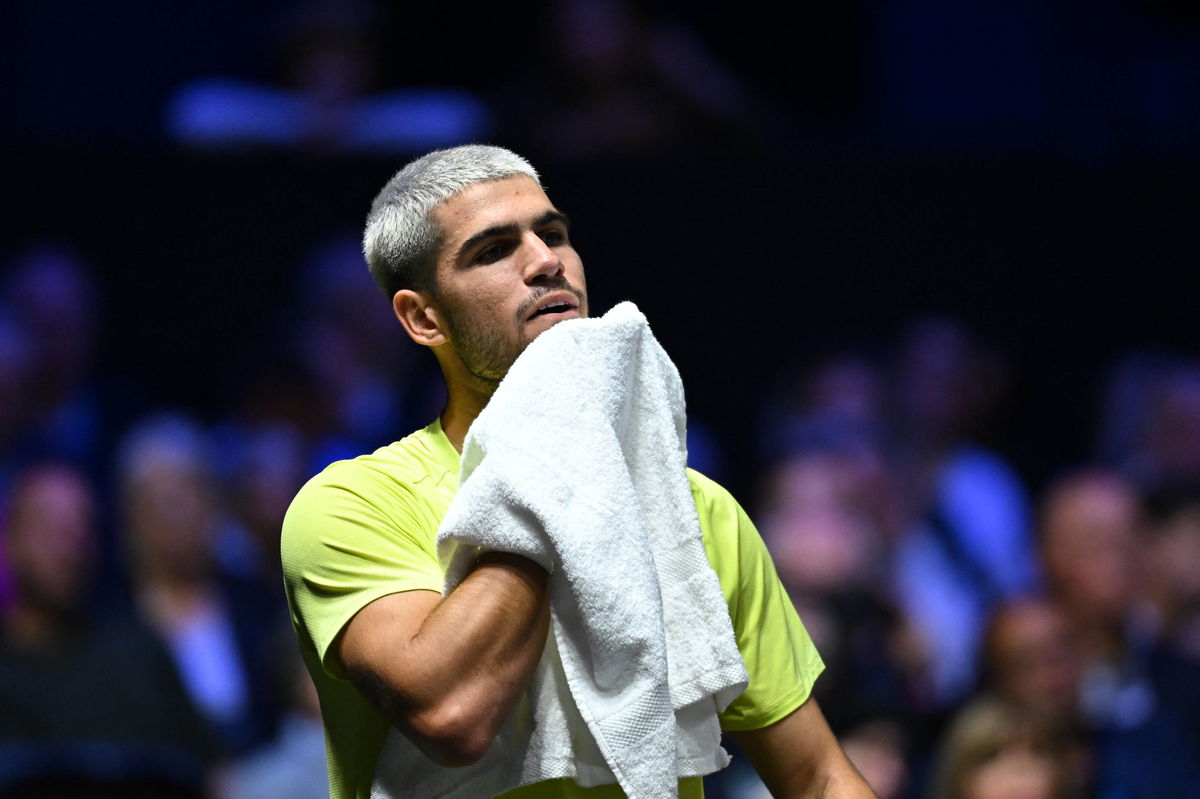
Imago
Rolex Paris Masters – First Round Carlos Alcaraz ESP during his first round match at the 2025 Rolex Paris Masters at the U Arena in Paris, FRANCE, on October 28, 2025. Photo by Corinne Dubreuil/ABACAPRESS.COM Paris France PUBLICATIONxNOTxINxFRAxUK Copyright: xDubreuilxCorinne/ABACAx

Imago
Rolex Paris Masters – First Round Carlos Alcaraz ESP during his first round match at the 2025 Rolex Paris Masters at the U Arena in Paris, FRANCE, on October 28, 2025. Photo by Corinne Dubreuil/ABACAPRESS.COM Paris France PUBLICATIONxNOTxINxFRAxUK Copyright: xDubreuilxCorinne/ABACAx
At the Shanghai Masters in October, players battled brutal heat and humidity, and many showed the wear and tear of a long year on tour. World No. 1 Carlos Alcaraz pulled out before the tournament even started with a left-ankle injury. No. 2 Jannik Sinner retired from his third-round match after cramping. And Novak Djokovic threw up during his round-of-32 match and later needed back treatment during his semifinal loss. Now, as the 2025 season wraps up and players immediately shift focus to 2026, the debate over the length and intensity of the tennis calendar is only getting louder. But will anything change in the near future?
Watch What’s Trending Now!
Most players agree something has to give, but the details are tough to nail down. “It just needs to be shortened up. It’s too much,” Taylor Fritz said when asked what he’d fix. Still, he doesn’t expect meaningful adjustments anytime soon. However, while change has been slow, there have been a few tweaks along the way.
Just a few hours ago, the Novak Djokovic-led Professional Tennis Players Association took to X, and sharing an ESPN article, they wrote, “Our lawsuit is aimed at fixing the very issues this article highlights — from calendar reform to player health and sustainability.”
ADVERTISEMENT
The ESPN article delves into the many problems of the modern tennis tour, from the lengthier Masters tournaments to the unsustainable number of mandatory tournaments players have to play each year to maintain their ranking points. But despite the calls to action, there has been little consensus reached on how things can and should be changed.
ESPN lays it out clearly: the season is relentless, the travel is nonstop, and players’ concerns have only intensified.
Our lawsuit is aimed at fixing the very issues this article highlights — from calendar reform to player health and sustainability.
Read the full article here:… pic.twitter.com/uGW1HubNeQ
— Professional Tennis Players Association (@ptpaplayers) November 17, 2025
It is this very question that Djokovic and the PTPA are aiming to get answered. While the ATP and WTA protect the interests of players and tournaments, Djokovic began the PTPA as a body that protected only the players. But the push for change fizzled out, and then came the lawsuit against various tennis bodies across the US and Europe including the ATP and WTA.
ADVERTISEMENT
The PTPA’s demands put players at the forefront: more prize money for players, uniformity in ball types, and most significantly, a shorter tennis calendar.
“A season schedule that not only is shorter and makes sense but also allows for meaningful rest and recovery for the players, and a better voice and representation that means we don’t have to resort to these extreme measures every five or 10 years,” said the PTPA.
ADVERTISEMENT
Players like Carlos Alcaraz and Coco Gauff have long since been vocal about the toll the tour takes on players, with Alcaraz saying the schedule was trying to “kill” players. Though their complaints were initially included in the PTPA’s suit, they have since been removed, as neither Gauff nor Alcaraz was named as a plaintiff in the lawsuit.
But with the legal battles poised to be lengthy and expensive affairs, it’s hard to say when or if the changes they seek to make will come to fruition. But the PTPA’s grievances aside, there have been attempts to introduce meaningful change.
ADVERTISEMENT
Other changes discussed by the ATP and WTA
The Billie Jean King Cup final, which had been played in November in recent years, was already moved to September to give WTA players a longer offseason. This year’s event was also held in Shenzhen, China, for the first time, making it easy for players to roll right into the Asian swing. Playoffs to determine qualifying teams for the 2026 event still took place from Nov. 14-16 and will feature 21 countries. Meanwhile, the Davis Cup kept its usual late-November spot, running from Nov. 18 to 23 in Bologna, Italy. But that’s not all…
Larger changes have also been discussed. In 2024, the four Grand Slams began early talks about a new “Premier Tour,” a streamlined season built around the majors plus roughly 10 additional events and a year-end championship. The idea was to simplify the calendar and give top players a more focused schedule.
In response, the WTA and ATP pitched their own version of the plan, saying it was meant to “restructure the sport.” Their proposal included the four Slams, ten 1000-level tournaments, and a revamped lineup of 500-level events, while reducing the number of 250s through license buybacks. This would cut the combined number of tournaments from 118 to about 75.
ADVERTISEMENT
But they couldn’t get the Grand Slams to sign on, reportedly because they couldn’t agree on how the new governing board would be set up. So while it looks like real change may still be a long way off, it’s clear that tennis’ main bodies are in agreement that something does indeed have to change.
ADVERTISEMENT
ADVERTISEMENT
ADVERTISEMENT

